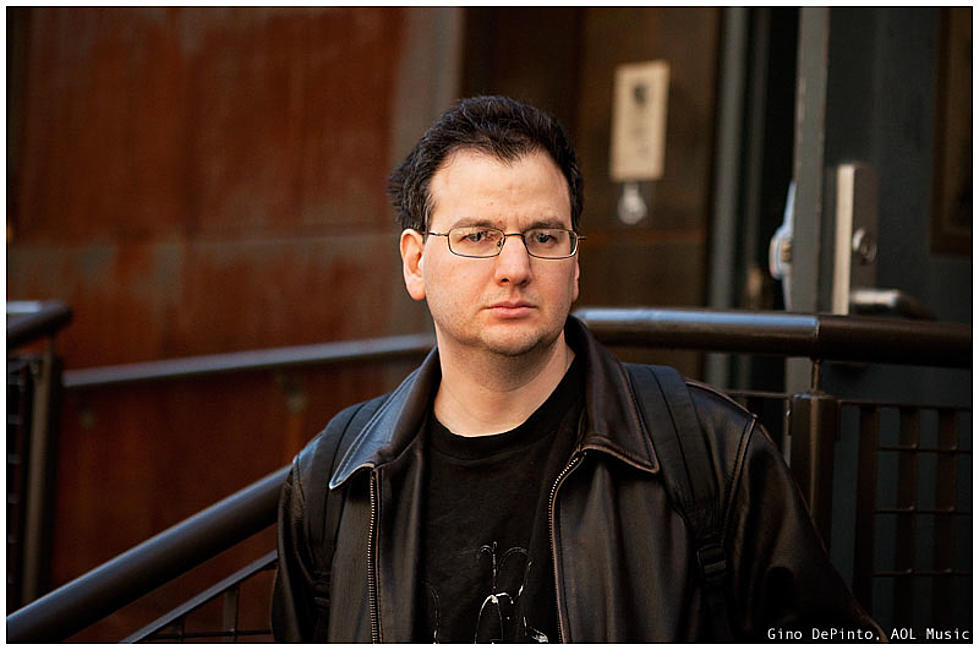Kirk Hammett: "I love that Greeny has its own fanbase that’s completely independent of me"
The metal icon details how he came to own Peter Green's legendary Les Paul, where it fits in Metallica's sound, and his own tributes to the Fleetwood Mac co-founder
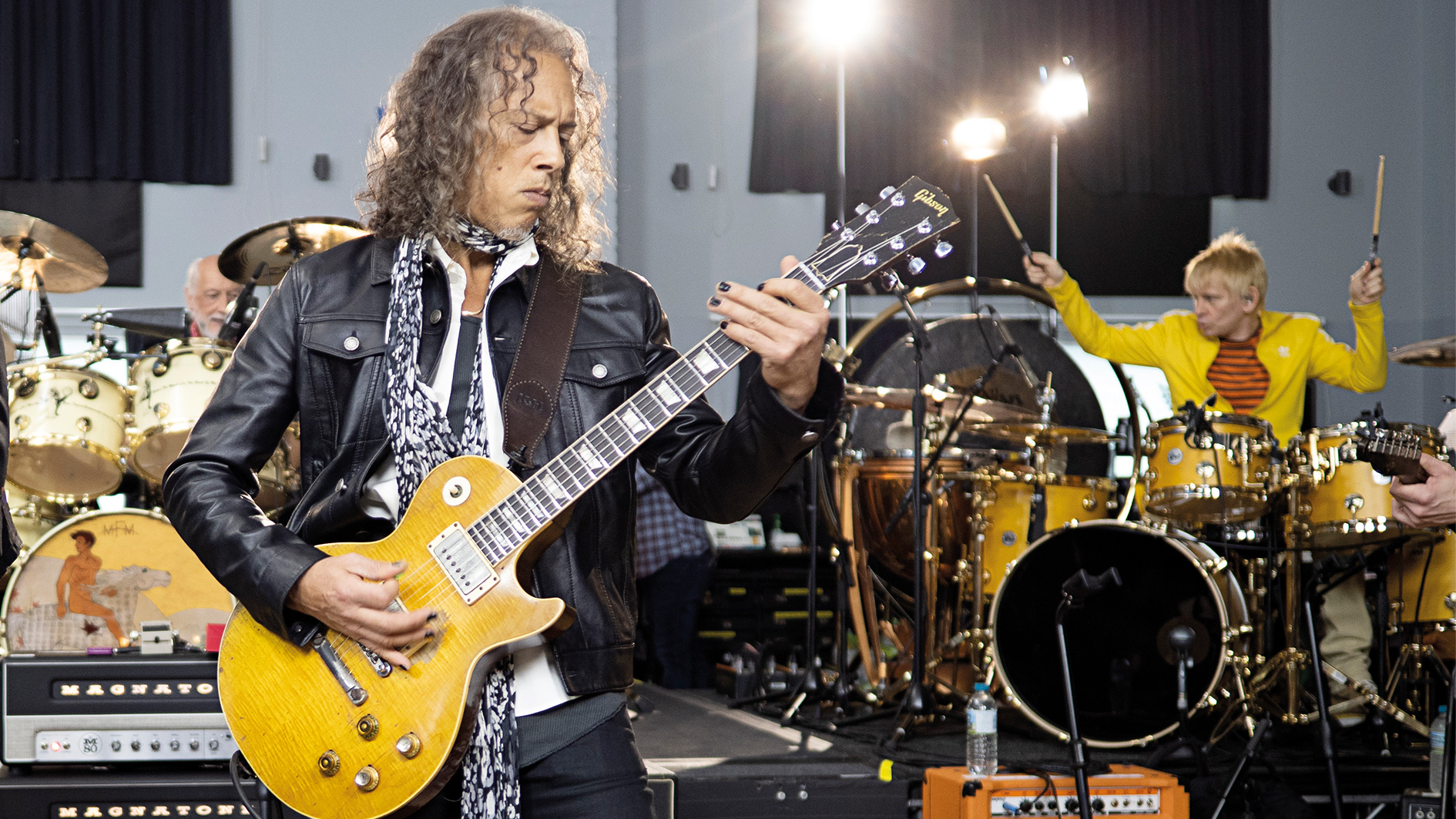
Forget BB King's Lucille, Eric Clapton’s Blackie and Brownie, Keith Richards’ Micawber. Nevermind Willie Nelson’s Trigger, Prince’s Cloud, Jimmy Page’s Dragon and Eddie Van Halen’s Frankenstrat. For Metallica guitarist Kirk Hammett, the anthropomorphized guitar that strikes the deepest chord in his soul is a 1959 Gibson Les Paul Standard named Greeny.
Steeped in history and mystique, the instrument was originally owned by Fleetwood Mac co-founder Peter Green. It was subsequently purchased by Gary Moore, who played it in Thin Lizzy and on his best- known blues-rock albums over the next 30 years, after which he sold it to Phil Winfield at Maverick Music. The company’s website later posted it for sale - reportedly for $2 million.
A couple of private investors owned the instrument for brief periods; then, six years ago, Hammett bought the guitar. Metallica’s resident shredder, a devoted fan of Green’s iconic blues playing, was excited to own the legendary instrument, which features a tone unlike any other Les Paul.
The welcome aberration happened when Green replaced the neck pickup and accidentally put it in backwards, creating an out-of-phase sound when played in the middle position.
Standing on the same stage as Billy Gibbons, Pete Townshend and John Mayall pushed me into another zone
In addition to having a distinct tone, the guitar resonates with the vibe and spirit of its former owners, Hammett says, adding that since he started playing Greeny he has become a more spontaneous and dedicated artist.
“Every single time I pick her up, she makes me a better player,” Hammett says. “I’m obsessed with her. I bring her everywhere with me. Where I sleep, she sleeps, basically. And I try to play her as much as possible because she wants to be played.
"She deserves to be played and she has such a beautiful sound and tone that people want to hear her. I’m constantly amazed by the amazing mojo of that guitar.”
Get The Pick Newsletter
All the latest guitar news, interviews, lessons, reviews, deals and more, direct to your inbox!
On February 25, Hammett demonstrated his blues chops - with the help of Greeny - at an event dubbed “Mick Fleetwood & Friends Celebrate the Music of Peter Green and the Early Years of Fleetwood Mac”, which took place at the London Palladium.
It also included performances by David Gilmour, Pete Townshend, Bill Wyman, Christine McVie, Steven Tyler, Billy Gibbons, Neil Finn, Jeremy Spencer and Noel Gallagher. The house band for the show was composed of drummer Mick Fleetwood, guitarists Andy Fairweather Low, Rick Vito and Jonny Lang, bassist Dave Bronze and keyboardist Ricky Peterson.
Each artist performed a song written or made famous by Green; Hammett capped the evening by playing the last song Green recorded with Fleetwood Mac, The Green Manalishi (With the Two-Prong Crown), which also featured drummer Zak Starkey and five other guitarists, including Lang, Vito, Gibbons and Fairweather Low.
While Fleetwood Mac’s studio recording of Green Manalishi didn’t include a guitar solo, Green sometimes soloed during the song during live performances, so Mick Fleetwood gave Hammett his blessings to let fly, and the guitarist played a blazing solo for almost two minutes.
It was a homecoming for Greeny, and I felt like I was just along for the ride. The guitar was driving, and I was there observing the scenery as it went by
“He said I could solo as long as I wanted, so I dug deep within myself and played with as much emotion as I could,” Hammett says. “I played all my darkest licks and a handful of Peter Green stuff as well for good measure, and it was magical. It was a homecoming for Greeny, and I felt like I was just along for the ride. The guitar was driving, and I was there observing the scenery as it went by.”
Hammett also performed Shake Your Moneymaker with most of the evening’s performers. “I’m thankful it was caught on camera because it was a transcendent experience for me,” Hammett says. “Standing on the same stage as all those legends like Billy Gibbons, Pete Townshend and John Mayall pushed me into another zone.”
The Palladium show will come out as a concert film later this year, and Hammett and Gilmour have both worked on early Fleetwood Mac songs to accompany Green’s limited-edition coffee table art book, I Suppose I Do Enjoy Being Me, which will be out later this year via UK-based Rufus Publications.

For the project, Hammett entered Abbey Road Studios and recorded Fleetwood Mac’s Man of the World. Gilmour wrote a new arrangement for Mertis John’s Need Your Love So Bad (which Fleetwood Mac famously covered in 1968) then flew in Green’s original vocals.
Long after finishing his tea and pastry, Hammett was still waxing rhapsodic about early Fleetwood Mac, the recent Peter Green tribute show, Green himself, Greeny and the long history of one of rock’s most legendary guitars.
What was your very first exposure to Fleetwood Mac?
"When I was growing up, I listened to a lot of '70s radio, and Fleetwood Mac was on every 15 minutes. That Rumors album was huge. At the time I had no idea the band had done its first three albums with Peter Green and they sounded totally different."
You played Green Manalishi (With the Two Prong Crown) at the benefit. That was Green’s last single with Fleetwood Mac. When did you first hear it?
"I have to admit I was introduced to that song by Judas Priest when they covered it on [1979’s] Unleashed in the East. I looked at the label one day and saw the song credits: 'Peter Green, John McVie and Mick Fleetwood,' and I went, 'Huh, what’s this about?' I asked someone and he said, 'Oh yeah, it’s old Fleetwood Mac.'
I always liked darkness and I still do. I have that outlook, that perspective, that awareness
"I said, 'What do you mean old Fleetwood Mac?' And he said, 'Yeah, Fleetwood Mac used to be a blues band.' He gave me a tape of Green Manalishi and some of their other songs, including Rattlesnake Shake and Black Magic Woman. I listened to it and really, I felt like it was more rocking than their stuff on the radio."
How do you feel Fleetwood Mac’s original Green Manalishi compares to the Judas Priest version?
"In retrospect, I obviously have a lot of respect for Judas Priest, and their cover version of Green Manalishi is really heavy.
"But the original is dark as night and it comes from a deep, deep place in Peter Green’s soul. It resonates from within, and I can relate to it from the dark place in my own soul. I always liked darkness and I still do. I have that outlook, that perspective, that awareness."
Are your side projects also steeped in darkness?
"Yeah, that darkness colors a lot of the music I compose. I’ll get on a dark thread when I’m writing and I stay on it, and that turns into riffs and chord progressions and songs. I’ve recorded a lot of really dark stuff on my own. I mean, when you hit that tritone or that harmonic minor scale - the Phrygian dominant scale - you’re not thinking about flowers or the altruistic aspects of humanity.
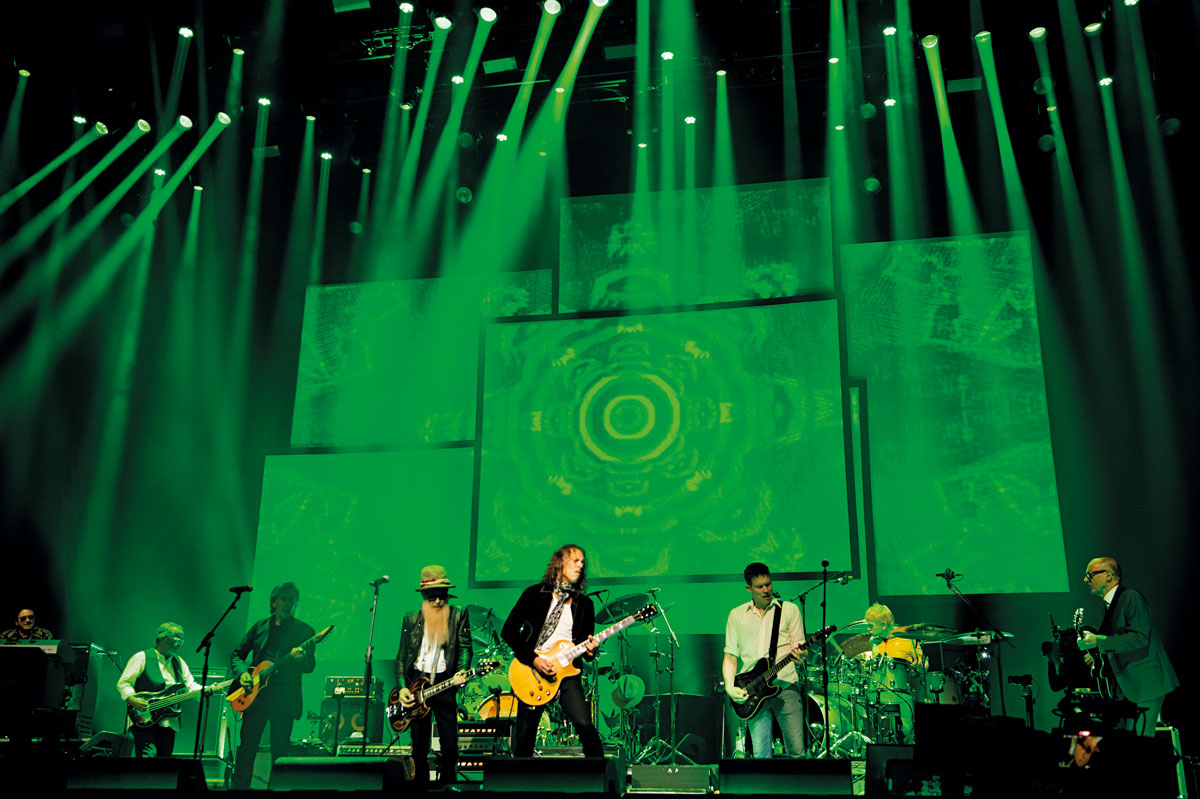
"You’re thinking about the end of the world and doom and gloom and total Armageddon. It’s a natural reaction. And like myself, there’s a lot of people out there that crave that darkness. It’s cathartic. It feels good. It lets me go to the darker parts of life and experience them without really experiencing them and coming out okay at the other end."
You’re a huge fan of horror movies. Could some of your darker compositions find their way into a film score?
"I would love to do that. I have stacks of dark ambient shit that would work perfectly. But I’ve never been asked, because everyone thinks of me as the guitarist of Metallica. I love being that, but it would be cool to branch out a little. That’s why I’m so excited about the Peter Green stuff and some other things I’m working on."
How did you get involved with the Peter Green benefit concert?
If I look at it as three calendar years’ worth of dates, I tend to get overwhelmed and freaked out and then all of a sudden I don’t want to do any of it
"Word got around to Mick Fleetwood that I had gotten the Peter Green guitar, so about four years ago he asked me if I wanted to be a part of a Peter Green’s Fleetwood Mac show. At that time, Metallica were about to embark on a huge worldwide tour. It hadn’t even begun, so I had no idea what my schedule was going to be like.
"Mick wanted to do the tribute in 12 or 15 months and I couldn’t commit to that. But it didn’t seem like Mick had a specific date in mind. So I said to him, 'You know, I am interested but I can’t commit right now. I’d love to do this when I’m not touring, but I really don’t know when that will be.'
"I purposely keep myself in the dark about my touring schedule and just approach it three months at a time. If I look at it as three calendar years’ worth of dates, I tend to get overwhelmed and freaked out and then all of a sudden I don’t want to do any of it. That’s happened to me in the past, so I make it a point now just to worry about the next three months, and that’s a lot healthier for my brain."
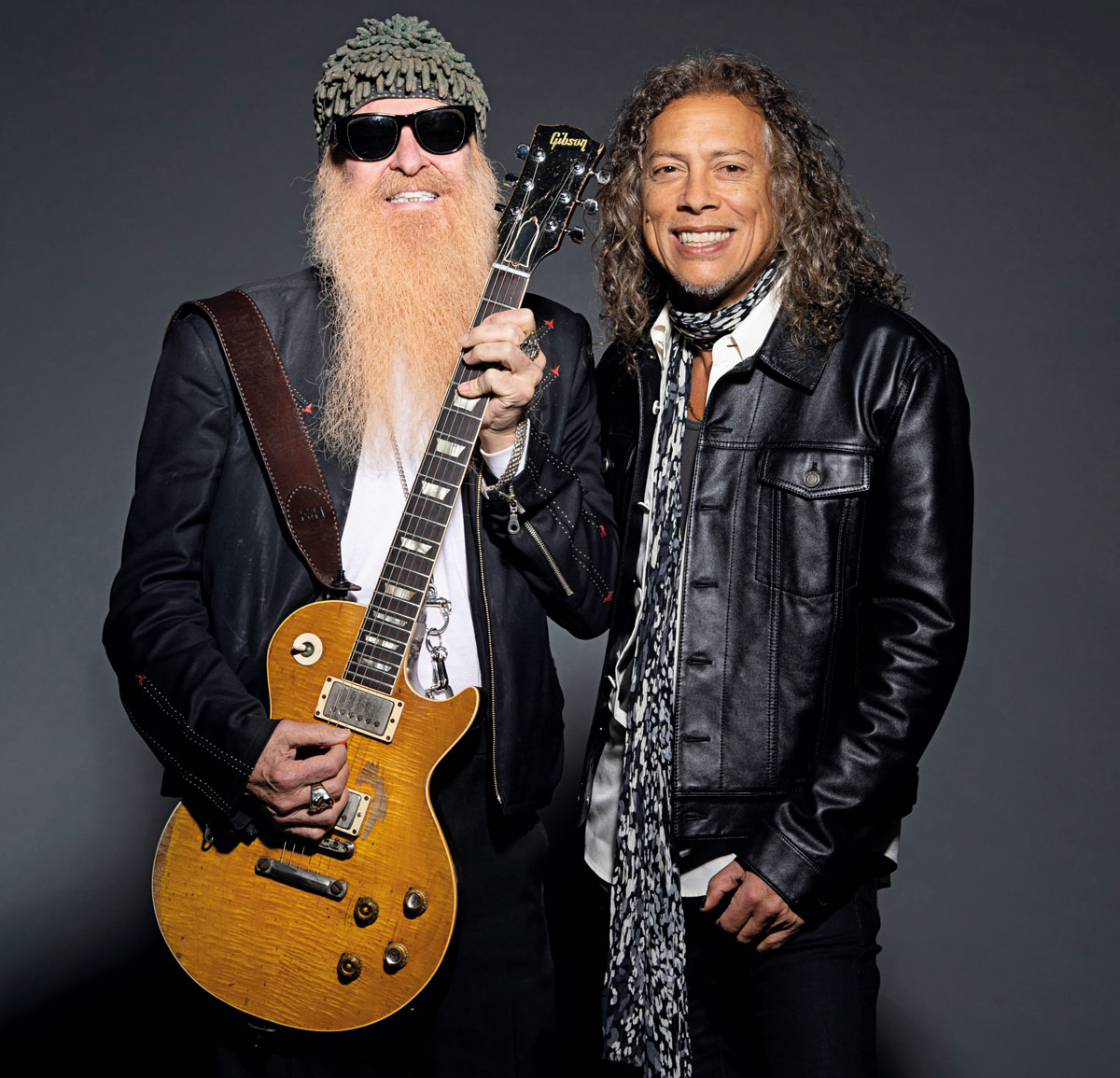
Did Mick Fleetwood wait until you were available to schedule the event?
"Fast forward two-and-a-half years and I found out from [photographer] Ross Halfin that it was starting to take shape and form. Ross said I should contact Mick Fleetwood. I thought, 'Well, heck, Metallica is two thirds of the way through this world tour. And I think as the tours go on we have more and more free time.'
"I emailed Mick and told him I would love to be a part of it but I needed to know the date. He said it would happen in February 2020 and I thought, that’s perfect."
Did you tell him in advance what you wanted to play?
"I told him how much Green Manalishi was a huge part of my playing - both the Fleetwood Mac version and the Judas Priest version - and Mick said, 'Great, that’s fantastic.' I didn’t know at the time, but he had always intended for me to play Green Manalishi.”
Were there rehearsals before the event?
"Mick has a house in Maui [Hawaii], and I spend a lot of time in Oahu, so I went over and spent a couple days in Maui and rehearsed with him and Andy Fairweather Low, who is a great guitar player.
"Amazingly Dave Mason [who played in Fleetwood Mac from 1993 to 1995] and a couple of people from his core blues band were there. I was super nervous at first, and I later found out that they were nervous, too. But once the anxiety settled, everything fell into place."
How did you settle your jitters and get onto the same page as them?
When I first walked into the room I was definitely the scary heavy metal guy. So, between takes, when I was just standing around, I played all these blues licks and they all warmed up to me
"When I first walked into the room I was definitely the scary heavy metal guy. So, between takes, when I was just standing around, I played all these blues licks by Robert Johnson with the sound down and when they heard that, they all warmed up to me. It was really amazing to be standing there with Glynn Johns, John Mayall and Bill Wyman just talking the blues. It was a great icebreaker."
Did you find there was a bit of a learning curve in the rehearsals?
"There was no learning curve. I had Greeny, who was the main driver of that song, and I just plugged into a relatively clean Vox analog amp. Right off the bat, it sounded full, heavy, dark - the way it should be. At the end of it, we were all shaking our heads going, 'Yup, this is going to be great.'
"About four weeks later, we all convened in London at rehearsal and played it a couple times with the extended core band, which included Jonny Lang and Zak Starkey, and it sounded even heavier with the two drummers.
"Afterward, Mick said, 'You know the song was slated for the middle of the set but we’re going to have to move it to the end because it’s going to be a hard act to follow.' I was immensely pleased by that comment, of course."
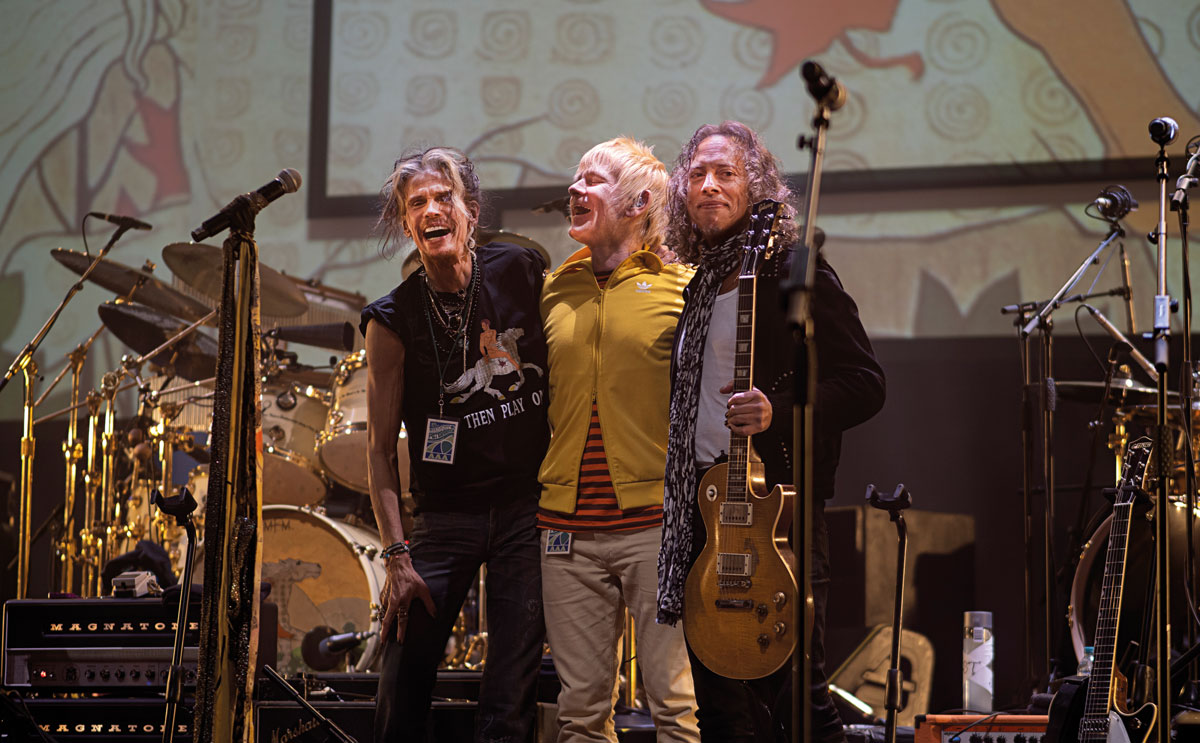
The benefit took place February 25, 2020. You met Peter Green a while before that.
"I met him in L.A. in January 2019 and it was a very intense experience. I knew he was this genius player who had schizophrenia [and had some bad acid experiences] that messed with his head.
"For years, he was ill. He has better meds now and from what people are telling me he’s the sharpest he’s ever been. He’s much, much more coherent, and when I met him I thought he was great. It was intense, though, because he was checking me out and trying to read what I was all about. But once we got on the subject of fishing, that kind of broke the ice.
"I did a lot of fishing from a boat as a kid so I know a lot about it, and from that point on talking to him was great. We talked for about 90 minutes about the early days of Fleetwood Mac and guitars. He still collects guitars and he still plays."
Did you have Greeny with you?
It was another full-circle experience. Greeny left him for almost 50 years and gained all this notoriety being involved in all this classic music
"That was kinda funny. I showed him Greeny and he said, 'That’s not my guitar. My guitar had a lot more red in it.' But he was willing to hold Greeny and take pictures with me and Greeny, and that was significant for me because it was the first time he had come into contact with that guitar since the early '70s.
"It was another full-circle experience. Greeny left him for almost 50 years and gained all this notoriety being involved in all this classic music. And then when I came over, Greeny came back into the hands of Peter Green [if just for a moment]. It was really touching."
Green lent Greeny to Gary Moore in the '70s and soon after convinced Moore to buy the guitar for $300, the same amount Green paid for it in 1966. Moore had the guitar for about 30 years.
"When I listen to Thin Lizzy’s Black Rose I can tell every track Greeny is on. It’s that distinct neck-pickup sound. And [Moore’s 1990 album] Still Got the Blues has a total Greeny sound. I love it when I hear Greeny when I’m out doing random things. I was at a comic store in New York about three years ago and I heard that tone. 'There’s Greeny.' The store was playing Fleetwood Mac’s Need Your Love So Bad."
Does it feel like Greeny calls out to you?
"I just notice her a lot more in everything and I remember every time I saw or heard her in the past. When I was 16, I was in a record store and I was looking at one of Gary Moore’s albums. I flipped it over and there he was playing Greeny and I thought, 'That’s gotta be the coolest shot of a guy playing a Les Paul, ever.'"
You’re the third famous guitarist to own Greeny. What drew you to the guitar?
"Originally, I heard that it was on the market and the asking price was $2 million and I scoffed. I was like, 'Man, whoever’s trying to sell that is just crazy.' So no-one bought it.
"Then, about six years ago, I was in London and a guitar dealer friend told me, 'Hey, I got Gary Moore’s guitar. Let me show it to you.' I said, 'Wait a second, I’m not paying $2 million for that.' He said, 'Oh no, it was never for sale for $2 million.' And I said, 'I’m not interested in a guitar for $1 million either.' My friend said, 'No, it’s very affordable, Kirk. Let me bring it over.' I thought, 'Okay, you know, I can just kind of humor him.'"
Were you interested in actually buying the guitar?
I looked at my friend and I was just grinning. 'I’m not giving it back to you.' It all happened within about two minutes
"I was a little curious. Late-'50s Les Pauls are my favorites and Les Paul Standards are amazing. They’re like the Stradivariuses of electric guitars. My friend brought over Greeny with a vintage Vox amp. I took it out of the case and I was like, yep, there’s the backward pickup. I plugged her in and started going through the pickups.
"The bridge pickup was really bright. I switched it to the neck pickup and it was nice and creamy. And then I switched it to the middle position, where you hear that out-of-phase sound because of the backward pickup, and I was shocked because it really sounded like a Strat cranked through a 100-watt Marshall.
"I looked at my friend and I was just grinning. 'I’m not giving it back to you.' It all happened within about two minutes. I said to him, 'Okay, you got me. You fuckin’ got me. I love this guitar. It’s amazing.'"
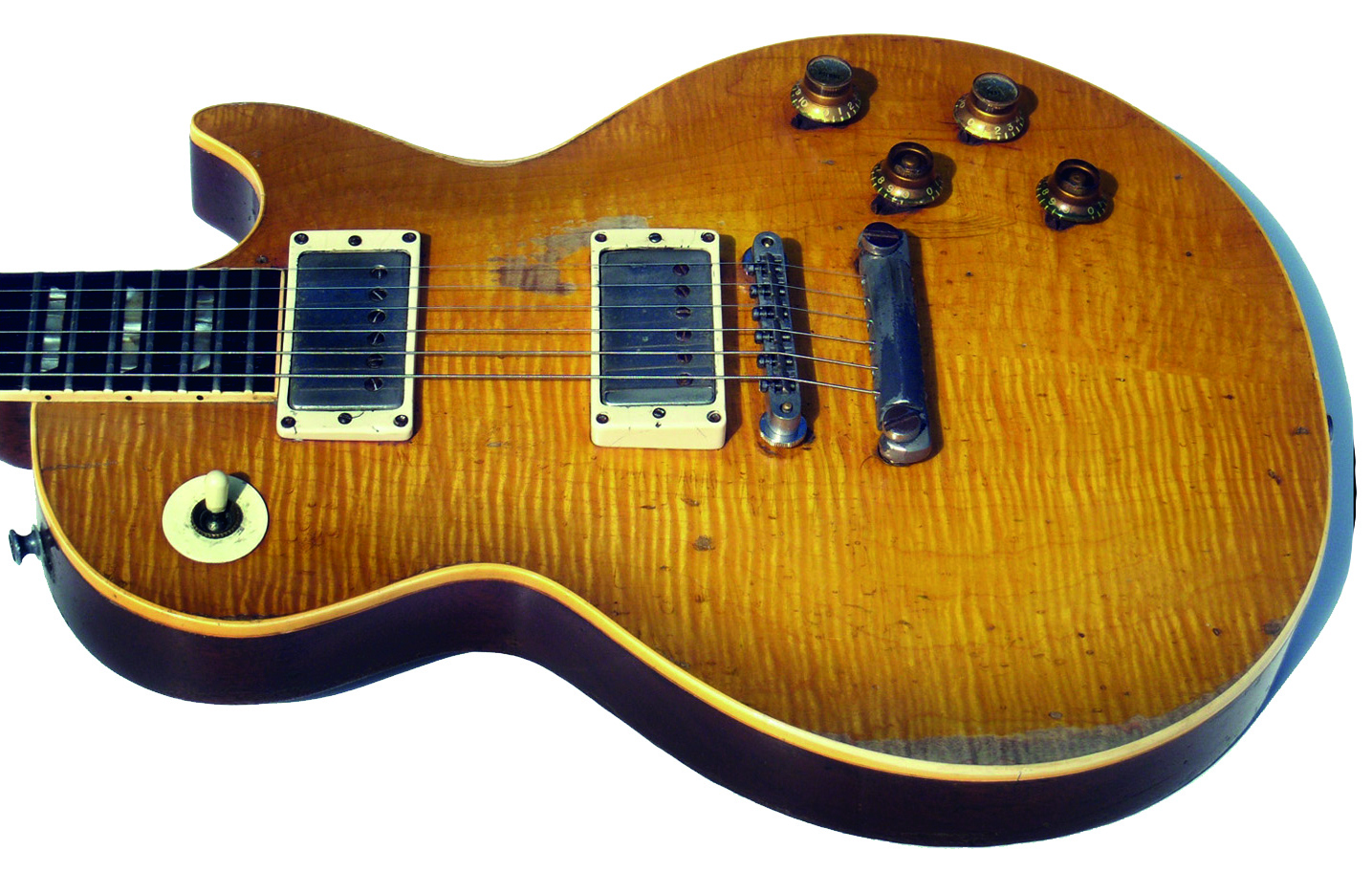
Sometimes people who purchase high-ticket items experience buyer’s remorse. Did that ever happen to you?
"Just the opposite. I was frantic about it. I got really paranoid and OCD about it being sold from underneath me. But in reality, no-one was interested in that guitar. They had shown it to Joe Bonamassa just the week previous and he wasn’t as impressionable as I was. But I was obsessed.
"I was calling up every day saying, 'Okay, do we have a deal yet? Okay, let’s work out a payment plan. Okay, so you got the check? Okay, when can you deliver the guitar to me?' I was kind of crazy about it.
"Once I finally got it in my hands, I just went, 'Yes!' And then I started noticing other aspects of it that I didn’t catch before. It was easy for me to play because it wasn’t too heavy. There were all these wear marks on it and a little mark from where Gary Moore rested his fingers when he played it. And the finish was cracked in the coolest way. I thought, 'This guitar has a vibe. I’m not letting it out of my sight.'"
You played Greeny on Metallica’s Hardwired… to Self-Destruct and you’ve taken it on tour. That’s a pretty valuable guitar to bring onstage.
I can sweat all over it or bleed all over it and it will always retain its value and its significance because of its history
"Usually, people put on white gloves when they handle a ’59 Les Paul because they’re so fucking rare and valuable. But I had an epiphany. I realized I’m in the best sort of situation I could be in.
"If this were any other guitar, the more I played it, the more the value would go down because it gets scratched, dented up and damaged. But Greeny already has a million dents and scratches. The neck was broken twice before I got it and it doesn’t matter because it still sounds amazing.
"So I can sweat all over it or bleed all over it and it will always retain its value and its significance because of its history."
Were you able to make Greeny work in Metallica right away?
"I started playing it immediately. I was able to get a really good working sound out of it because it’s different from all my other guitars. The other guitars I play onstage have active EMG pickups, and Greenie has classic [humbucker] pickups. But the pickups are so incredible-sounding.
"The output isn’t too high or too low. It’s right in that sweet spot where I can hear everything evenly and clearly. All of the different frequencies come out ringing. It was very easy to modify it to work for me onstage. A lot of times when you have a vintage guitar it doesn’t sound as good as these hot-rodded guitars. That wasn’t the case at all.
"The tone was there. I just hit a power chord and I was like, 'Oh my God, this is heaven.' And to play that super-loud, through a PA that’s 35 feet high in an empty stadium - it’s Greeny being where it wants to be, singing to all these venues filled with tens of thousands of people."
What did you actually pay for Greeny?
"I made a deal with the person I bought it from that I would never say what I paid for it. But it wasn’t $2 million. It wasn’t $1 million. It wasn’t even $500,000. That’s all I’ll say about it."
You mentioned that Greeny’s neck was broken twice. Do you know the details?
"Last year, I saw Neil Carter, who played in Gary Moore’s band and UFO [in the '80s], and he said to me, 'You know, I was with Gary Moore when Greeny was in the trunk and Gary got rear-ended by another vehicle.'
When they took Greeny out of the trunk they thought she was ruined. Amazingly, they found a guy who put her back together as good as new
"I said, 'Wait, you were there when Greeny’s neck was broken?' He goes, 'Oh yeah,' and then he told me the story. Gary Moore’s manager was supposed to put gas in the car. For whatever reason, he wasn’t able to. So they were going up the M1 and ran out of gas and got stuck there in the middle of the lane in the middle of the night. They got out of the car and were just sitting on the side of the road.
"And then, out of nowhere, this vehicle came down the road and tried to stop at the last second, but ended up hitting the car and it impacted the trunk and broke the guitar.
"When they took Greeny out of the trunk they thought she was ruined. Amazingly, they found a guy who put her back together as good as new. So after I heard that story I talked to my tech, who is British, and he thought about who he would have brought the guitar to if that had happened to him.
"And sure enough, it was the guy who repaired Greeny. He gave my tech a detailed account of what they did to put Greeny back together - the type of dowels they used, where they were inserted, the type of glue they used. And now my tech knows what to do if that kind of thing ever happens again."
Any other great Greeny stories?
"[Thin Lizzy guitarist] Scott Gorham told me that Gary Moore’s band Skid Row was playing a show once and this weird band made up of sketchy-looking characters was opening for them.
"After Skid Row came offstage, Greeny was gone, and so was the opening band. A guy at the club, though, who wasn’t a part of the crew or anything thought it was fishy and I guess he knew where the band was from. So he and a friend got in his car and started driving and eventually they saw the band and confronted them.
'Hey, did you guys take Gary Moore’s guitar?' 'No, no, no,' the band said. So the guy searched the van and while he was looking his friend suspected maybe someone took a walk with Greeny. He looked around and saw Greeny in the bushes.
"He quietly picked it up and put it in the back of their car and then went back over to his friend who was still arguing with the guys in the opening band. 'Okay, they don’t know anything. Let’s just go!' he said. They hopped into the car and sped off and Greeny made it back to Gary Moore."
Do Metallica fans recognize Greeny?
It’s kind of like how it would be if I was married to someone super famous and was constantly asked to step aside so they could take a picture with her
"I don’t start the show with that guitar. Greeny gets handed to me maybe seven or eight songs in. When I put it on and walk out I can see people pointing and whispering to each other. And signs come out saying, 'Greeny Lives!' And if we’re doing Fade to Black, I have to play it on Greeny.
"I love that Greeny has its own fanbase that’s completely independent of me. When I first got the guitar, my guitar-playing friends would bring over their Les Paul, set it right next to Greeny and take a picture of the two guitars.
"A lot of times I’ll be standing there and all of a sudden someone will say, 'Can I take a picture with Greeny?' I’m like, 'Yeah, sure.' I’ll have to take it off and give it to the person or set it on the stand and take their camera and shoot a photo for them.
"It’s kind of like how it would be if I was married to someone super-famous and was constantly asked to step aside so they could take a picture with her."
Do you sometimes feel like Greeny gives you superpowers?
"Whitfield Crane, the singer for the cover band I’m in, the Wedding Band, said something really funny. He went, 'Dude, Greeny is your Excalibur.' I said, 'What do you mean?' And he said, 'Well, you know, other people tried to have it but they couldn’t get it and now it’s your guitar and it’s like it has all these powers.'
"And I thought, 'Yeah, Excalibur. That’s what I use to slay the dragon.' And then I thought about it some more and 'the dragon tone' is what I call the middle pickup sound. So it’s almost like another 'coming home' moment. I don’t know. I just know I can hit a note and it will fucking sing for two minutes. It’s an amazing, amazing guitar.”
Jon is an author, journalist, and podcaster who recently wrote and hosted the first 12-episode season of the acclaimed Backstaged: The Devil in Metal, an exclusive from Diversion Podcasts/iHeart. He is also the primary author of the popular Louder Than Hell: The Definitive Oral History of Metal and the sole author of Raising Hell: Backstage Tales From the Lives of Metal Legends. In addition, he co-wrote I'm the Man: The Story of That Guy From Anthrax (with Scott Ian), Ministry: The Lost Gospels According to Al Jourgensen (with Al Jourgensen), and My Riot: Agnostic Front, Grit, Guts & Glory (with Roger Miret). Wiederhorn has worked on staff as an associate editor for Rolling Stone, Executive Editor of Guitar Magazine, and senior writer for MTV News. His work has also appeared in Spin, Entertainment Weekly, Yahoo.com, Revolver, Inked, Loudwire.com and other publications and websites.
“A virtuoso beyond virtuosos”: Matteo Mancuso has become one of the hottest guitar talents on the planet – now he’s finally announced his first headline US tour
“His songs are timeless, you can’t tell if they were written in the 1400s or now”: Michael Hurley, guitarist and singer/songwriter known as the ‘Godfather of freak folk,’ dies at 83
